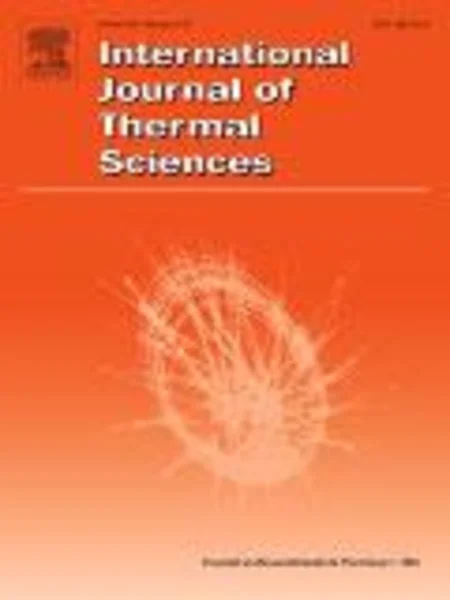-
development of a new forced convection heat transfer correlation for co2 in both heating and cooling modes at supercritical pressures
جزئیات بیشتر مقاله- تاریخ ارائه: 1390/01/01
- تاریخ انتشار در تی پی بین: 1390/01/01
- تعداد بازدید: 719
- تعداد پرسش و پاسخ ها: 0
- شماره تماس دبیرخانه رویداد: -
experimental and numerical investigations on forced convection heat transfer of carbon dioxide at supercritical pressures in a prototypic printed circuit heat exchanger under both cooling and heating conditions have been performed in this present study. the experiment test section has nine semi-circular channels with a hydraulic diameter of 1.16 mm and a length of 0.5 m. primary operational parameters include inlet pressure of 7.5–10 mpa, mass fluxes of 326 kg/m2 s and 762 kg/m2 s, inlet temperatures from 10 °c to 90 °c and the average heat flux was 30 kw/m2. beyond reproducing the regular experimental cases, numerical modeling also implemented higher heat fluxes of 60 kw/m2 and 90 kw/m2 in order to investigate the effect of heat flux. good agreement was found between the experiments and fluent simulations using an sst k–w model with the near-wall region being completely resolved. the distinctive behavior of convection heat transfer at supercritical pressures between heating and cooling modes was systematically analyzed. a more physically reasonable property-averaging technique, probability density function (pdf)-based time-averaged property, was developed to account for the effect of nonlinear dependency of properties on instantaneous local temperature. furthermore, experimental and computational data were compared to empirical predictions by the dittus–boelter and jackson correlations. the results showed that dittus–boelter correlation has better precision for the average value of the predicted heat transfer coefficient but cannot take account of the effect of heat flux. in contrast, the jackson correlation, with property ratio correction terms to account for the distribution of the properties in the radial direction, could predict the distinction of heat transfer characteristics under heating and cooling conditions. however, it overestimates the average value of heat transfer coefficient in the whole range of the experiment conditions. finally, a new correlation evaluated by pdf-based time-averaged properties for forced convection heat transfer of co2 in both heating and cooling mode at supercritical pressures was developed. comparison of experimental and computational data with the prediction results by the new developed correlation reveals that it works quite well; i.e., more than 90% data in either heating or cooling mode with various heat fluxes are predicted within an accuracy of ±25%.
حوزه های تحت پوشش رویداد
مقالات جدیدترین رویدادها
-
استفاده از تحلیل اهمیت-عملکرد در ارائه الگوی مدیریت خلاقیت سازمانی و ارائه راهکار جهت بهبود
-
بررسی تاثیر ارزش وجوه نقد مازاد بر ساختار سرمایه شرکت های پذیرفته شده در بورس اوراق بهادار تهران
-
بررسی تأثیر سطح افشای ریسک بر قرارداد بدهی شرکت های پذیرفته شده در بورس اوراق بهادار تهران
-
بررسی تأثیر رتبه بندی اعتباری مبتنی بر مدل امتیاز بازار نوظهور بر نقد شوندگی سهام با تأکید بر خصوصی سازی شرکت ها
-
تأثیر آمیخته بازاریابی پوشاک ایرانی بر تصویر ذهنی مشتری پوشاک ایرانی (هاکوپیان)
-
مقایسه پژوهش در زمینه بهینه سازی مصرف انرژی در ایران و ژاپن
-
بررسی و اولویت بندی هوش اخلاقی
-
نقش محوری طلا در هنر تشعیرسازی
-
بررسی الگوریتم های زمانبندی در وایمکس
-
numerical simulation of uniform flow region over a steeply sloping stepped spillway
مقالات جدیدترین ژورنال ها
-
مدیریت و بررسی افسردگی دانش آموزان دختر مقطع متوسطه دوم در دروان کرونا در شهرستان دزفول
-
مدیریت و بررسی خرد سیاسی در اندیشه ی فردوسی در ادب ایران
-
واکاوی و مدیریت توصیفی قلمدان(جاکلیدی)ضریح در موزه آستان قدس رضوی
-
بررسی تاثیر خلاقیت، دانش و انگیزه کارکنان بر پیشنهادات نوآورانه کارکنان ( مورد مطالعه: هتل های 3 و 4 ستاره استان کرمان)
-
بررسی تاثیر کیفیت سیستم های اطلاعاتی بر تصمیم گیری موفق در شرکتهای تولیدی استان اصفهان (مورد مطالعه: مدیران شرکتهای تولیدی استان اصفهان)
-
بررسی درک مصرف کننده از فعالیت های بازاریابی رسانه های اجتماعی بر ارزش گذاری برند، پاسخ مشتری و قصد خرید
-
بررسی تأثیر استراتژی مدیریت تنوع محصول بر عملکرد زنجیره تأمین در صنعت خودروسازی
-
عوامل طغیان و کنترل شهوت جنسی با نگاه قرآنی - حدیثی
-
تحلیل جایگاه صنعت گردشگری در توسعه استان ایلام و تدوین استراتژی توسعه بر پایه بخش گردشگری
-
green envelop impact on reducing air temperature and enhancing outdoor thermal comfort in arid climates




سوال خود را در مورد این مقاله مطرح نمایید :